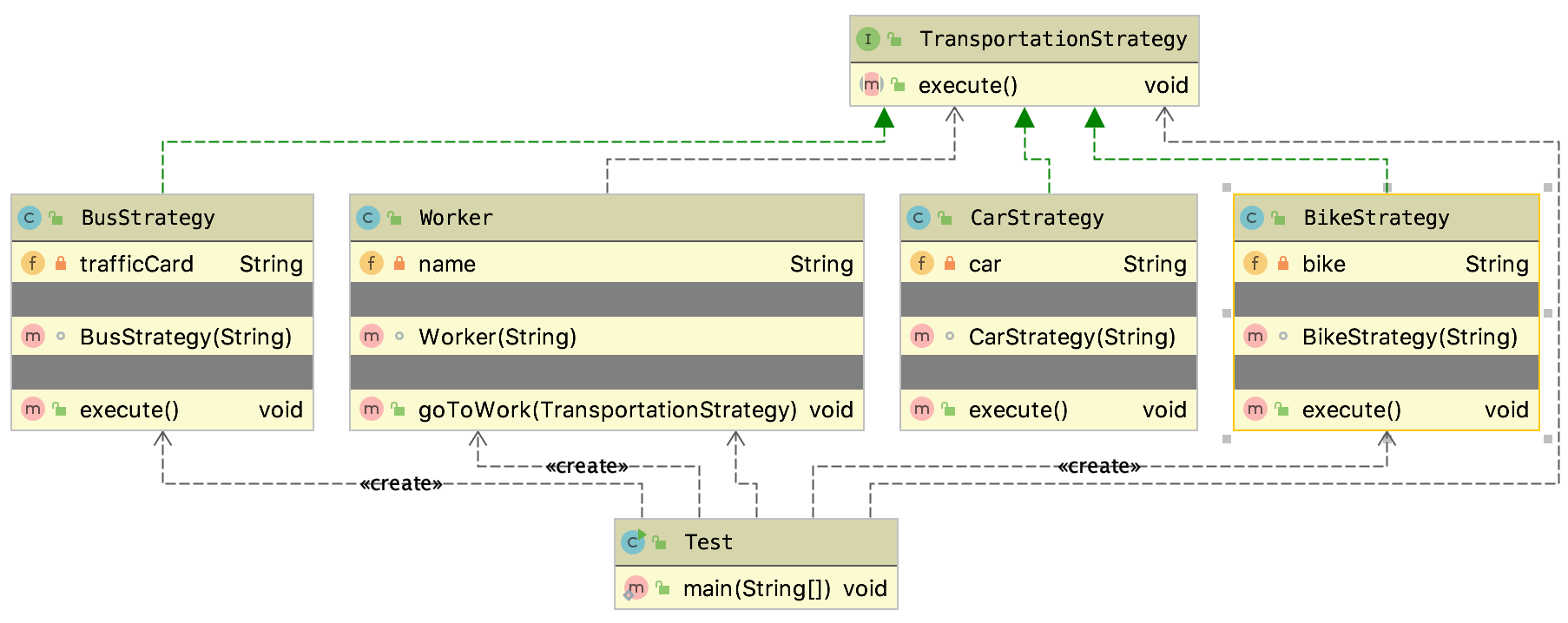1 概述
策略模式(Strategy Pattern)是行为模式的一种,复杂度并不高,当完成某项任务的方式有多种时,可以考虑使用策略模式。
2 策略模式
在策略模式中,我们需要定义一族算法,并将算法放入独立的类中,每种算法代表完成任务的一种方法。如计算器,我们可以定义基本的加,减,乘,除四种策略,对于任意输入的两个数字,调用不同的策略,将得到不同的结果;又如网上购物结算,我们可以定义一系列支付策略,支付宝支付,微信支付,信用卡支付,储值卡支付...顾客可以根据自己的喜好选择相应的支付方式。
策略模式解耦了算法的实现和定义。新引入策略,无需对现有逻辑进行修改,符合开闭原则。
3 案例
用一个案例来说明。对于上班族来说,上班方式有多种,可以开车,可以骑自行车,也可以坐公共交通。不同人有不同的选择,甚至对于同一个人,今天和明天的选择也会不一样,如果将上班方式维护在上班族这个类的内部,逻辑将会比较复杂。下面来看,通过策略模式将上班方式抽离出来,如何简化代码逻辑:
public interface TransportationStrategy {
void execute();
}
public class BikeStrategy implements TransportationStrategy {
private String bike;
BikeStrategy(String bike) {
this.bike = bike;
};
[@Override](https://my.oschina.net/u/1162528)
public void execute() {
System.out.println("Riding the '" + bike + "'bike...");
}
}
public class BusStrategy implements TransportationStrategy {
private String trafficCard;
BusStrategy(String trafficCard) {
this.trafficCard = trafficCard;
};
[@Override](https://my.oschina.net/u/1162528)
public void execute() {
System.out.println("Taking the bus with traffic card '" + trafficCard + "'...");
}
}
public class CarStrategy implements TransportationStrategy {
private String car;
CarStrategy(String car) {
this.car = car;
};
[@Override](https://my.oschina.net/u/1162528)
public void execute() {
System.out.println("Driving the '" + car + "'car...");
}
}
public class Worker {
private String name;
Worker(String name) {
this.name = name;
};
public void goToWork(TransportationStrategy strategy) {
strategy.execute();
System.out.println(name + " is on the way to office.");
}
}
public class Test {
public static void main(String[] args) {
TransportationStrategy BusStrategy = new BusStrategy("NO.9382-2345");
Worker link = new Worker("Link");
link.goToWork(BusStrategy);
TransportationStrategy bikeStrategy = new BikeStrategy("Giant");
Worker mario = new Worker("Mario");
mario.goToWork(bikeStrategy);
TransportationStrategy carStrategy = new BusStrategy("Tesla");
Worker yoshi = new Worker("Yoshi");
yoshi.goToWork(carStrategy);
}
}
输出:
Taking the bus with traffic card 'NO.9382-2345'...
Link is on the way to office.
Riding the 'Giant'bike...
Mario is on the way to office.
Taking the bus with traffic card 'Tesla'...
Yoshi is on the way to office.

通过定义一个抽象层TransportationStrategy,使得代码结构清晰,组件之间的耦合度也很低。选择不同的策略类,便能完成相应的功能。
我们最熟悉的例子,应该是JDK中的Collections.sort()方法,该方法可以根据传入的Comparator的不同,将List按不同的算法排序,其中Comparator就是策略。
4 总结
合理地运用策略模式,可以降低系统的复杂度。当一个类包含了多种行为,表现为多个if分支时,可以考虑用策略模式将每个行为做成一个策略类。
来源:oschina
链接:https://my.oschina.net/u/2411391/blog/4289188